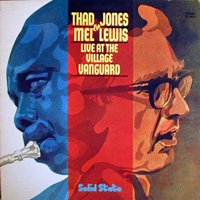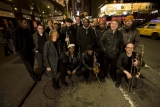Here’s a heads-up for the annual LOST JAZZ SHRINES Spring concert series produced by Willard Jenkins for Tribeca Performing Arts Center:
|
Here’s a heads-up for the annual LOST JAZZ SHRINES Spring concert series produced by Willard Jenkins for Tribeca Performing Arts Center:
|
The Ancient Future radio program has shifted timeslots to Thursday morning drivetime – 5:00-8:00am. The program now features three distinct segments: Anthology (5:00am-6:30am), Soundviews (6:30am-7:00am; an extended listen to the weekly Soundviews new/recent release), and the New Release Hour (7:00am-8:00 featuring new & recent releases).
Playlist in the following order: Artist – Tune – Album Title – Label.
Anthology: Thad Jones-Mel Lewis Orchestra
Thad Jones-Mel Lewis Orchestra "Don’t Git Sassy" Live at the Village Vanguard Blue Note
Joe Williams w/Thad Jones-Mel Lewis Orchestra "Get Out My Life Woman" Blue Note
Thad Jones-Mel Lewis Orchestra "A Child is Born" Jones-Lewis (anthology) Blue Note
Thad Jones-Mel Lewis Orchstra "A Hunk A Hunk" Consummation Blue Note
Thad Jones-Mel Lewis Orchestra "For The Love of Money" Potpourri Philadelphia International
Thad Jones-Mel Lewis Orchestra "Groove Merchant" Basle 1969 TCB
Joe Zawinul/WDR Big Band "Brown Street" Brown Street HeadsUp
Jazz meets Hip Hop w/Sekou Sundiata "Sister Cheryl" 2008 Tri-C JazzFest Collection
Irma Thomas "Early in the Morning" Simply Grand Rounder
Soundviews Feature
Joe Zawinul & The Zawinul Syndicate "Badia/Boogie Woogie Waltz" 75 HeadsUp
Joe Zawinul & The Zawinul Syndicate "Orient Express" 75 HeadsUp
Joe Zawinul & The Zawinul Syndicate "In a Silent Way" 75 HeadsUp
New Release Hour
Blue Note 7 "Criss Cross" Mosaic Blue Note
Ed Reed "All Too Soon" Blue Shorts
Benny Golson "Uptown Afterburn" New Time, New ‘Tet Concord
David Binney "Third Occasion" Third Occasion Mythology
Barbara King "Ribbon in the Sky" Perfect Timing CCC
Mark Masters Ensemble "Boody" Farewell to Walter Dewey Redman Capri
Do you know what it means to miss… (Mardi Gras)?
(selections listed in playlist order by artist, track, album title and label)
1) New Birth Brass Band, "Hush Your Mouth", New Birth Family, Valley
2) Professor Longhair, "Big Chief" pt. 1, Mardi Gras in New Orleans, Mardi Gras Records
3) John Boutte, "At The Foot of Canal Street", At The Foot of Canal Street, Valley
4) Professor Longhair, "Big Chief" pt. 2, Mardi Gras in New Orleans, Mardi Gras Records
5) Adonis Rose & the N.O. Vaders, "’Lil Liza Jane", Untouchable, House Swing
6) Irma Thomas, "Early in the Morning", Simply Grand, Rounder
7) Donald Harrison, "I’m The Big Chief of Congo Square", The Chosen, Nagel Heyer
8) Matt Perrine, "New Orleans Blues", Sunflower City, (no label listed?)
9) George French, "Gloryland", It’s a Beginning, Nia
10) Shannon Powell, "Powell’s Place", Powell’s Place, King of Treme
11) Ed Blackwell, "Nevermore", Boogie Live 1958, AFO
12) Harold Battiste, "We’ll Be Together Soon", Lagniappe, AFO
13) Germaine Bazzle, "Secret Love", Standing Ovation, AFO
14) Herlin Riley, "Trouble in Treme", Cream of the Crescent, Criss Cross

Dream Lucky, the new book by Roxane Orgill (Smithsonian Books 236pp) would make splendid firestarter for a film. Subtitled "When FDR was in the White House, Count Basie was on the radio, and everyone wore a hat…" the book is a beautiful stroll through the late 1930s using the Roosevelt administration, with Eleanor as an essential and quite resonant subtext, and the parallel evolution of Count Basie from territory band member then band chief, to his not-without-pitfalls conquering of Manhattan, to renowned road warrior bandleader to provide vivid context to the era. Included also are chapters that shine a vivid light on the big band contrasts between the Benny Goodman and Chick Webb (with Ella as subtext in the manner of Eleanor to Franklin) outfits and their eventual historic confrontation at the Savoy Ballroom. I found the passages on Reverends Adam Clayton Powell Sr. and (and eventual congressman) Jr. particularly strong, especially Jr.’s dogged and dashing determination and boycott leadership to open up Harlem businesses as employers of it’s black residents. As they say in the publishing game, this is a true page-turner and highly recommended. Ms. Orgill handles this colorful period in our history with aplomb and wry humor.


Thad Jones-Mel Lewis Jazz Orchestra births a tradition
Being on the campus of the University of Missouri February 17 & 18 for a NEA Jazz Masters Live site-visit for a presentation of Jon Poses’ exceptional We Always Swing series brought home just how special the Monday Night big band tradition is in New York. As their participation in the NEA Jazz Masters Live funding program which supports a select number of presenting organizations to engage NEA Jazz Masters in special programming, We Always Swing had the brilliant idea of commissioning NEAJM Bob Brookmeyer to write a new piece for the Grammy-winning Vanguard Jazz Orchestra. The concert and premiere of the new work, a suite entitled simply "Suite For Three" (written to spotlight three stellar VJO soloists: saxophonists Dick Oatts and Rich Perry, and trumpeter Scott Wenholdt played to a robust house at the University of Missouri Theatre. But all the brilliance of their performance aside, let’s for a moment ponder just how difficult it is in the 21st century to bring an entire big band from New York all the way out to Columbia, Missouri for a one-nighter; sure makes you realize just how special this effort was! The concert was also special for some marvelous solo turns from one of the finest trumpeters in the music, Terell Stafford. Drummer John Riley kept the pots cooking in the grand tradition of Mel Lewis, and the band boasts one of the great baritone players of our time Gary Smulyan.
The preceding day as part of their NEAJM project the organization presented two interview sessions; the first featured NEAJM and renowned jazz historian-journalist Dan Morgenstern in a one-on-one reminiscing in tempo session with Bob Brookmeyer at the Univerisity of Missouri School of Music. That was followed by Brookmeyer and Morgenstern being joined onstage by two of the Vanguard Jazz Orchestra’s co-leaders, trombonists Douglas Purviance and John Mosca to further reflect on the storied 44+ year history of the orchestra which has morphed in that time from the Thad Jones-Mel Lewis Orchestra to the Mel Lewis Orchestra (upon Thad’s departure to Denmark) to what is now the Vanguard Jazz Orchestra (VJO), fresh off their Grammy win for the 2008 Planet Arts release "Monday Nights". Brookmeyer, a charter member of the band and frequent contributor to its book, told funny stories about how the band started in rehearsals upstairs from the musician’s hang-out Jim & Andy’s, and about further adventures. What became the Thad Jones-Mel Lewis Jazz Orchstra officially launched on Monday, February 2, 1966. Purviance and Mosca, both of whom came onboard in the 70s, spoke about how special it has been to play in the band and how Monday nights at the Vanguard have evolved over the years — including the three evolutions of the band to the point where today leadership is shared by five members, including themselves.
I asked them a question about how the band first locked down the Monday night at the Vanguard gig and learned that when it all started at the time there was a musician’s union ban on Monday night gigs, which were officially designated as musician’s night off. They were able to circumvent that edict and since that time their storied gig has spawned all sorts of regular and semi-regular Monday night band gigs at clubs around Manhattan, none of which has enjoyed the longevity of the VJO, the grandaddy of them all. I was reminded of an encounter a couple of weeks ago with two large ensembles on a Monday night in Manhattan.

Mingus Big Band
Of all the jazz widows of great masters my hat has long been off to Sue Mingus for the tireless way she has gone about maintaining and upholding the legacy of Charles Mingus and his music. The Mingus Big Band is currently enjoying a Monday night residency at the Jazz Standard, a club which among other things enjoys hands-down the best menu and cooking of any jazz club in Manhattan. Among her many efforts Sue Mingus has been quite clever about doing more than just ensuring gigs for the Mingus Big Band, Orchestra, and Dynasty; she has always stayed one step ahead of the game by seeking fresh approaches to their presentations. For example this year they’re celebrating the 50th anniversary of three important Mingus records: "Blues and Roots", "Ah Um", and "Dynasty". So the band is performing music pretty much exclusively from those three sessions — though they did veer off into some slightly more obscure Mingus from his "Baron Mingus" days for a vocal selection — and the results are bracingly fresh as always.
Nominal co-leadership of the band appears to be shared by bassist Boris Kozlov, who performs on Charles’ famed lion’s head bass, and tenor saxophonist Wayne Escoffery, who also share the various intros. Among other marvelous moments on this particular evening were excursions into such Mingus lore as "My Jelly Roll Soul" and "GG Train", tunes that have not been often performed otherwise. Among the stalwarts in the big band on that particular Monday were saxophonists Vincent Herring, Abraham Burton, Jason Marshall, and Donny McCaslin; trumpeters Randy Brecker, Kenny Rampton, and former VJO trumpeter Earl Gardner (still one of the best lead trumpeters on the planet), trombonists Frank Lacy (who contributed one of his customary humorous vocal turns) and Andy Horton, Donald Edwards on drums, and the bracingly fresh Orrin Evans on piano, who injected some wicked clave into one of his turns. When a band boasts such sturdy soloists it can be difficult for each to get a proper turn, but indeed each did as the set was very skillfully arranged.

Properly refreshed I headed over to Roulette for a large ensemble performance of a different flavor, Percussionist-composer Adam Rudolph’s Go Organic Orchestra. Rudolph, known by some for his long-standing duo with the great reedman Yusef Lateef, is a man who has long straddled the fence between jazz, improvising music, and various global music expressions. On this night his Go Organic Orchestra was a string-heavy ensemble that included such notables as cornetist Graham Haynes, reed specialist J.D. Parran, and guitarists Leni Stern and Kenny Wessel — through a program of his original music heavily steeped in the Butch Morris school of gestural conduction. Appropos the fresh flavor of Rudolph’s conduction, when I arrived the first people I spotted just off the entrance to the performance space were Butch Morris and Henry Threadgill! Just another wintry Monday night in Manhattan!